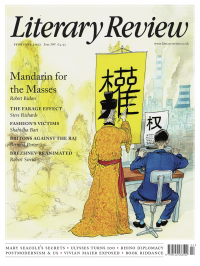D J Taylor
What Do Critics Know?
Literary historians often amuse themselves with the sensibility time-lag, which can be defined as the gap – usually only a few years, but sometimes amounting to several decades – between popular taste and highbrow taste. John Gross’s The Rise and Fall of the Man of Letters (1969) is full of this kind of thing. Among its many case studies, one might note the fate of Robert Montgomery’s epic poem The Omnipresence of the Deity (1828), a colossal pre-Victorian bestseller that had reached its eleventh edition before being demolished by one of Macaulay’s famous broadsides.
In fact, as Gross reveals, The Omnipresence of the Deity went through another seventeen editions before falling off the map. It is a similar story with the work of the Reverend George Gilfillan (1813–78), a dissenting minister from Dundee, who beguiled unsophisticated readers with his three-volume A Gallery of Literary Portraits, written up in a billowing, hyper-emphatic style. Gilfillan was, additionally, a champion of the so-called Spasmodic school of early Victorian poets (such as Sydney Yendys and J Stanyan Bigg) and it was a lampoon of this patronage – Firmilian, A Spasmodic Tragedy by William Aytoun – that supposedly sent his reputation tumbling over the

Sign Up to our newsletter
Receive free articles, highlights from the archive, news, details of prizes, and much more.@Lit_Review
Follow Literary Review on Twitter
Twitter Feed
It wasn’t until 1825 that Pepys’s diary became available for the first time. How it was eventually decrypted and published is a story of subterfuge and duplicity.
Kate Loveman tells the tale.
Kate Loveman - Publishing Pepys
Kate Loveman: Publishing Pepys
literaryreview.co.uk
Arthur Christopher Benson was a pillar of the Edwardian establishment. He was supremely well connected. As his newly published diaries reveal, he was also riotously indiscreet.
Piers Brendon compares Benson’s journals to others from the 20th century.
Piers Brendon - Land of Dopes & Tories
Piers Brendon: Land of Dopes & Tories - The Benson Diaries: Selections from the Diary of Arthur Christopher Benson by Eamon Duffy & Ronald Hyam (edd)
literaryreview.co.uk
Of the siblings Gwen and Augustus John, it is Augustus who has commanded most attention from collectors and connoisseurs.
Was he really the finer artist, asks Tanya Harrod, or is it time Gwen emerged from her brother’s shadow?
Tanya Harrod - Cut from the Same Canvas
Tanya Harrod: Cut from the Same Canvas - Artists, Siblings, Visionaries: The Lives and Loves of Gwen and Augustus John by Judith Mackrell
literaryreview.co.uk